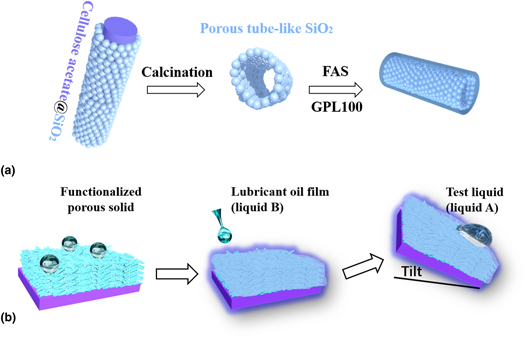Crossref Citations
This article has been cited by the following publications. This list is generated based on data provided by
Crossref.
Guo, Lin
Tang, G. H.
and
Kumar, Satish
2020.
Dynamic Wettability on the Lubricant-Impregnated Surface: From Nucleation to Growth and Coalescence.
ACS Applied Materials & Interfaces,
Vol. 12,
Issue. 23,
p.
26555.
Goodband, Sarah J.
Armstrong, Steven
Kusumaatmaja, Halim
and
Voı̈tchovsky, Kislon
2020.
Effect of Ageing on the Structure and Properties of Model Liquid-Infused Surfaces.
Langmuir,
Vol. 36,
Issue. 13,
p.
3461.
Prakash, C.G. Jothi
and
Prasanth, R.
2020.
Recent trends in fabrication of nepenthes inspired SLIPs: Design strategies for self-healing efficient anti-icing surfaces.
Surfaces and Interfaces,
Vol. 21,
Issue. ,
p.
100678.
Buddingh, Jasmine V.
Hozumi, Atsushi
and
Liu, Guojun
2021.
Liquid and liquid-like surfaces/coatings that readily slide fluids.
Progress in Polymer Science,
Vol. 123,
Issue. ,
p.
101468.
Sun, Lingyu
Guo, Jiahui
Chen, Hanxu
Zhang, Dagan
Shang, Luoran
Zhang, Bing
and
Zhao, Yuanjin
2021.
Tailoring Materials with Specific Wettability in Biomedical Engineering.
Advanced Science,
Vol. 8,
Issue. 19,
Li, Dandan
Lin, Zaiwen
Zhu, Jiahui
Yu, Jing
Liu, Jingyuan
Liu, Zhenze
Chen, Rongrong
Liu, Qi
Liu, Peili
and
Wang, Jun
2021.
An engineering-oriented approach to construct rough micro/nano-structures for anticorrosion and antifouling application.
Colloids and Surfaces A: Physicochemical and Engineering Aspects,
Vol. 621,
Issue. ,
p.
126590.
Goodband, Sarah J.
Kusumaatmaja, Halim
and
Voïtchovsky, Kislon
2022.
Development of a setup to characterize capillary liquid bridges between liquid infused surfaces.
AIP Advances,
Vol. 12,
Issue. 1,
Karkantonis, Themistoklis
Gaddam, Anvesh
Sharma, Himani
Cummins, Gerard
See, Tian Long
and
Dimov, Stefan
2022.
Laser-Enabled Surface Treatment of Disposable Endoscope Lens with Superior Antifouling and Optical Properties.
Langmuir,
Vol. 38,
Issue. 37,
p.
11392.
Peethan, Alina
Pais, Mikitha
Rao, Padmalatha
Singh, Kulwant
and
George, Sajan D.
2022.
Wettability tailored superhydrophobic and oil-infused slippery aluminium surface for improved anti-corrosion performance.
Materials Chemistry and Physics,
Vol. 290,
Issue. ,
p.
126517.
Yang, Guang
Zhang, Zhimin
Li, Chengqiang
and
Hu, Jianqing
2023.
A facile approach to fabricate omniphobic and robust polyurethane coatings for anti-smudge, anti-ink.
Progress in Organic Coatings,
Vol. 179,
Issue. ,
p.
107488.
Miao, Shuangshuang
Cao, Xinyue
Lu, Minhui
and
Liu, Xiangdong
2023.
Tailoring micro/nano-materials with special wettability for biomedical devices.
Biomedical Technology,
Vol. 2,
Issue. ,
p.
15.
Dawson, Jack
Coaster, Samual
Han, Rui
Gausden, Johannes
Liu, Hongzhong
McHale, Glen
and
Chen, Jinju
2023.
Dynamics of Droplets Impacting on Aerogel, Liquid Infused, and Liquid-Like Solid Surfaces.
ACS Applied Materials & Interfaces,
Vol. 15,
Issue. 1,
p.
2301.
Manoudis, Panagiotis N.
Zuburtikudis, Ioannis
Khalifeh, Hadil Abu
and
Karapanagiotis, Ioannis
2024.
Robust and transparent smooth amphi-repellent coating with physical self-cleaning and photocatalytic activities.
Surfaces and Interfaces,
Vol. 52,
Issue. ,
p.
104928.
Rakheja, Tanmay
Pathak, Prateek
and
Grewal, H.S.
2024.
Facile fabrication of super-slippery and transparent glass with anti-fogging and self-cleaning characteristics.
Materials Letters,
Vol. 366,
Issue. ,
p.
136506.
Zhang, Junning
Liu, Sida
Kanokkanchana, Kannasoot
Kuzina, Mariia
Zhou, Meijun
Du, Xin
Gu, Zhongze
Dong, Zheqin
and
Levkin, Pavel A.
2025.
Fabrication of 3D Functional Nanocomposites Through Post‐Doping of Two‐Photon Microprinted Nanoporous Architectures.
Small,
Vol. 21,
Issue. 5,


